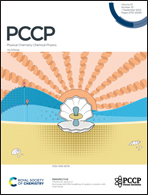Excited-state singlet–triplet inversion in hexagonal aromatic and heteroaromatic compounds†
Abstract
The inversion of the energies of the lowest singlet (S1) and lowest triplet (T1) excited states in violation of Hund's multiplicity rule is a rare phenomenon in stable organic molecules. S1–T1 inversion has significant consequences for the photophysics and photochemistry of organic chromophores. In this work, wave-function based ab initio computational methods were employed to explore the possibility of S1–T1 inversion in hexagonal polycyclic aromatic and heteroaromatic compounds. In these molecules, the highest occupied molecular orbital (HOMO) and the lowest unoccupied molecular orbital (LUMO) are two-fold degenerate. The HOMO–LUMO transition gives rise to three singlet and three triplet excited states. While the singlet–triplet energy gap ΔST, defined as the energy difference between the S1 state and the T1 state, is clearly positive for benzene, it is predicted to be close to zero for borazine, the boron nitride analogue of benzene. Although ΔST decreases with increasing size of hexagonal polycyclic aromatics, it remains positive up to circumcoronene (19 rings). However, symmetry-preserving substitution of C–C pairs by B–N groups in the interior, keeping the conjugation of the outer rim intact, results in compounds with robustly negative ΔST. These findings establish the existence of a new family of boron carbon nitrides with inverted singlet–triplet gaps.

- This article is part of the themed collection: 2023 PCCP HOT Articles


 Please wait while we load your content...
Please wait while we load your content...